While thousands of investors continue to earn great returns at Lending Club and Prosper, the bulk of the country has yet to even hear about it. This is slowly changing as seen in the greater frequency of peer to peer lending being mentioned (Forbes) in major news outlets. And the potential Lending Club IPO (FT.com) may also bring greater awareness. It seems more and more people each day are becoming curious about this new and exciting way to invest.
That said, there is a definite “leap of faith” involved when going from being interested in peer to peer lending to actually investing in it with your own money. For most Americans (typically people in their later years), registering personal information on an unfamiliar website and portioning it with thousands of dollars in trial cash is a fairly large pill to swallow.
To help these prospective investors, I have broken down the average registration and investment process below. Keep in mind that these are simply the basic steps to get a feel for this investment. If you are trying to understand peer to peer lending for the first time, you should instead watch LendingMemo’s video course or read my ebook. On the other hand, if you already have a good feel for peer to peer lending, you may want to forego the 80 A-grade notes and instead invest $5,000 within 200+ loans of your liking.
Note: this article shows the process via Lending Club. However, the process is generally the same on the other equally-deserving platform, Prosper. On Prosper, you would invest $2,000 in their safest grade: AA loans.
5 Steps for a P2P Lending Trial Investment
Step 1: Open an account (free)
The first step is simply to open an investor account with Lending Club (link).
Overall, the application form is very simple and easy to fill out, requiring you to provide typical information like your name, address, and social security number.
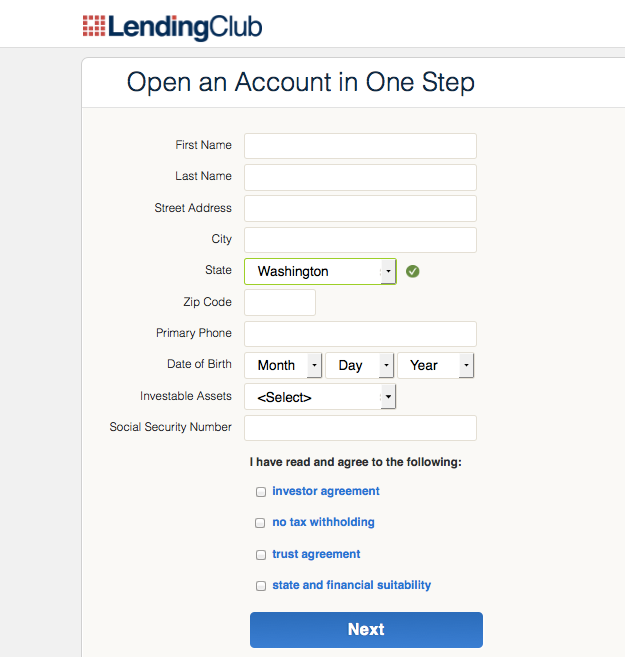
You have to provide a few extra pieces of information, including:
- Your state of residence: many states are not yet open to peer to peer lending (like Ohio or Texas).
- Regular or retirement account: retirement accounts (like a Roth IRA) have a different application than regular/taxable accounts. Read: the benefits of a p2p IRA. That said, most people only commit to something like an IRA once they have gotten a feel for this asset class via a regular account.
Step 2: Log in to your account
Once you have completed the application, you can log in using your email address and password. Once logged in, you will see the Account Summary screen below. Next it’s time to connect your bank through the Bank Account link.
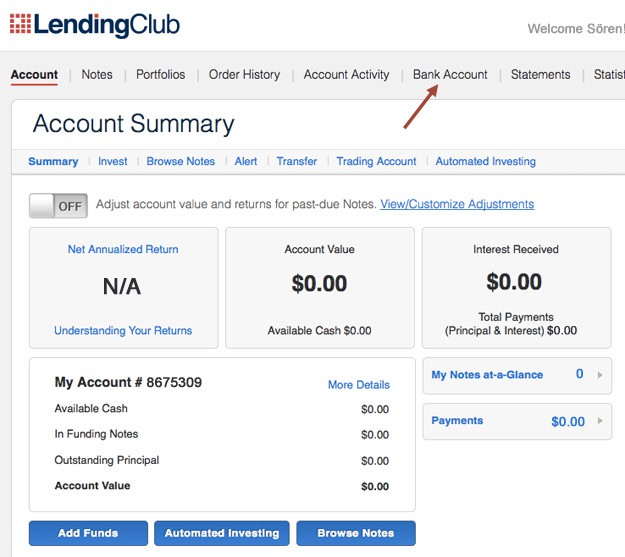
Step 3: Connect bank account and add funds to invest
On the Bank Account page you can connect your checking or savings account to Lending Club. Once this is complete, go to the Transfer link and move some money into your account.
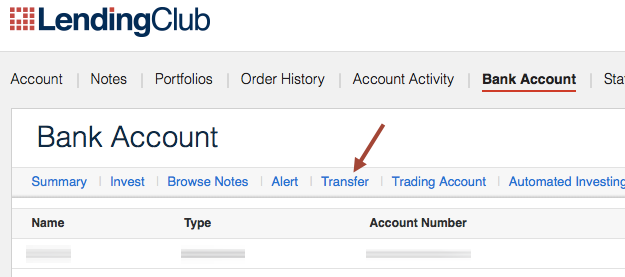
Important: the amount you choose to invest will vary by individual, but should be at least $2,000. This will allow you to diversify in 80 lower-risk A-grade notes (80+ notes at $25 per note = $2K). If you want to make a trial investment across all the grades, you will need to transfer over at least $5,000. This will allow diversification across the entire risk spectrum (200+ notes at $25 per note). Further reading: my simple and advanced article on diversifying your p2p account.
Step 4: Invest $25 in 80+ A-grade notes (AA-grade on Prosper)
Now comes the big moment. If you have at least $2,000 in available cash, click the link for Browse Notes. A large list of available loans will appear on your screen. You are going to invest in a $25 note (or portion) within 80 of these loans.
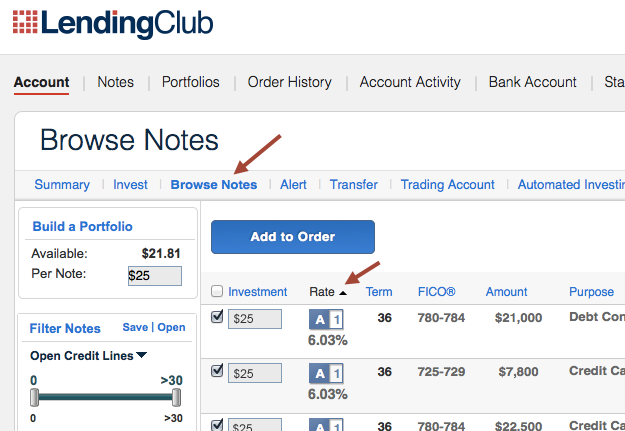
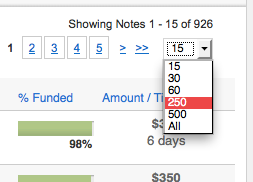 To find A-grade loans, you will need to sort the available loans by clicking the Rate column. This will cause all the safest A-grade notes (dark blue in color) to appear on your screen. You may want to click the dragdown menu (see right) and select for 250 loans to appear on your screen. Now simply check 80 of these A-grade notes (making sure to invest just $25 in each) and click the blue Add to Order button above. You will now be able to review your order on the View Order page.
To find A-grade loans, you will need to sort the available loans by clicking the Rate column. This will cause all the safest A-grade notes (dark blue in color) to appear on your screen. You may want to click the dragdown menu (see right) and select for 250 loans to appear on your screen. Now simply check 80 of these A-grade notes (making sure to invest just $25 in each) and click the blue Add to Order button above. You will now be able to review your order on the View Order page.
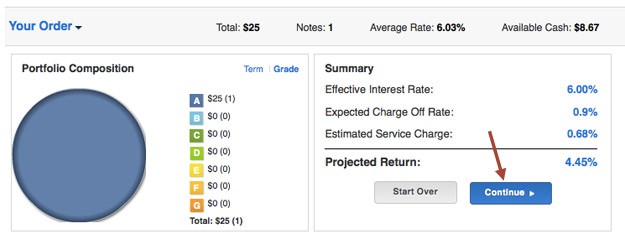
If everything is to your liking, you can click Continue to come to the Place Order screen.
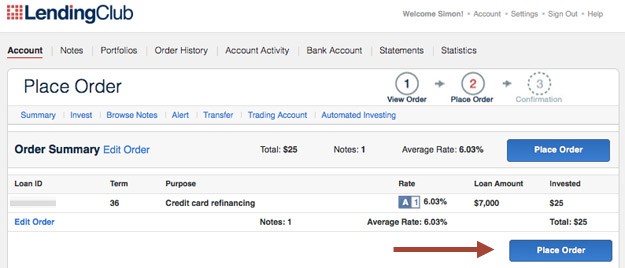
Clicking the Place Order button will invest your funds into these loans.
Investing Note 1 – This may take a few days: There may not be 80 A-grade loans available on the platform. When writing this article, there were actually just 58 available. If you do not find 80 A-grade loans (likely), you may need to log back in across a few different days until all your cash is put to work.
Investing Note 2 – Ignore loan descriptions: You can see each loan’s description (borrower profile, credit history, etc.) by clicking on it.
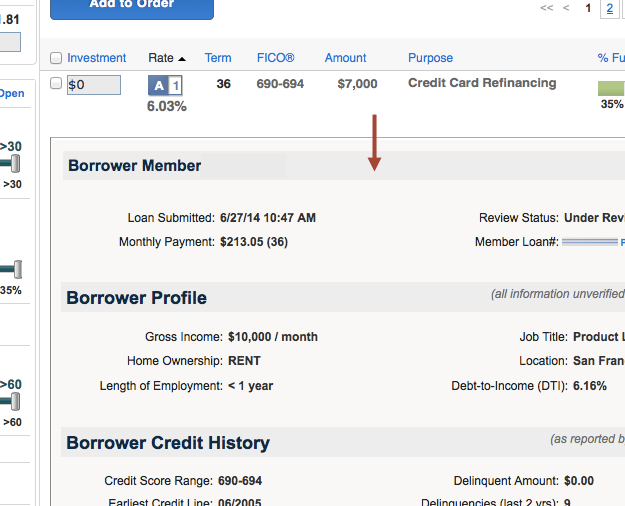
These descriptions, while interesting to read, are unimportant for most beginner investors. This is because all the loans at sites like Lending Club and Prosper are underwritten, meaning each loan has already been filtered by the platforms themselves, so every loan is already likely to be a good investment (particularly A-grade loans). Sometime in the future, you may want to try increasing your returns through filtering your invested loans by different criteria for a marginal performance bump (IE: lending to borrowers with a large annual income). But for now, consider all A-grade loans to be exactly what Lending Club says they are: safer, lower-risk, top-grade investments that can be counted on for a consistent return.
That said, it is a great idea for beginners to read these loan specifics, not to increase returns, but to get a feel for the asset class, to get a feel for these borrowers and for peer to peer lending in general.
Investing Note 3 – With $5,000 or more you can invest in lots of grades: This article emphasizes that you need 80 A-grade notes for a diversified peer to peer lending account. This means a minimum of $2,000 (80*$25=$2K). However, with $5,000+ you can invest in 200 notes (200*$25=$5K) across lots of grades – the safer A-grades through the riskier G-grade loans. Read my article on the relationship of diversification and risk. With $10K, you can bump your note value up to $50 (200*$50=$10K) or $100 notes with $20K. In summary, the most important thing here is diversifying in 200 notes, no matter how large they are.
Step 5 – Reinvest returns
Once this initial deposit is completely invested and 30 days has passed, your borrowers will begin making payments on their loans. These repayments will begin to flow into your account as available cash, and it is your responsibility to invest this cash into additional notes. You can do this by (1) logging in a few times throughout the month to put your cash to work in more A-grade loans, or (2) setting up Automated Investing to do this for you (minimum account $2,500; see picture below). Note: in Automated Investing, be sure to place 100% of your investment in A-grade loans.
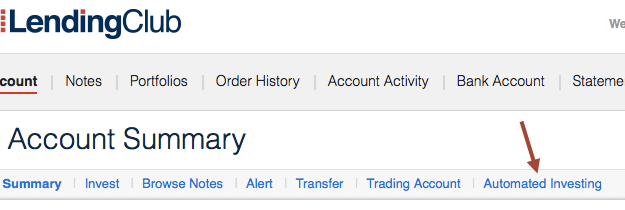
Alternatively, you could simply move repayments back into your bank account through the Transfer link. Whatever the case, try and keep available cash as low as possible. Cash drag can be a major factor in lowering your overall return (read more here).
Feel Comfortable with Peer to Peer Lending
The goal of putting a smaller amount like $2,000 to work at a place like Lending Club or Prosper is that this trial investment will allow you to experience 90% of the p2p investor process. You will not interact with loan grades or IRA investing, but you will get a feel for what this entire investment is all about – the large scale lending of money to people over the internet. In short, it will simply help you get acquainted (and even earn you a respectable return in the meantime).
Once you feel comfortable with the safer loan grades, you may want to explore adding additional risk (lower loan grades) so as to boost your overall return. For instance, Jack’s reader story shows an investor who began with safer loans, but eventually added additional risk and found these investments to be even more appealing:
“After one year I switched my strategy to loan grades of C and below, since it seemed people were getting better returns in these riskier loans without a large increase in defaults. On Lending Club I went from an 8% to almost a 10% return in the past 18 months by switching to this strategy.” – Jack (source)
There are actually a lot of ways for investors to increase their returns (see six of them), but many first need to just feel comfortable with this entire thing. If this is the case for you, investing in 80+ A-grade notes should do the trick.
My hope is that you will discover this overall investment to be a peaceful and lucrative way to put your extra money to work, that you will make it part of your life as it has become a part of mine.
[image credit: Felix Montino “Backflip into 4°” CC-BY 2.0]

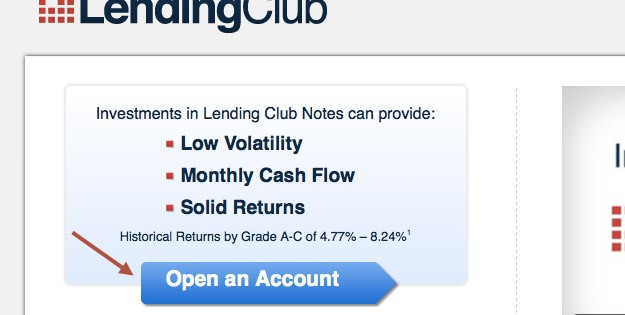
Great idea for an article. I’ve spoken with a number of people about P2P lending and they are definitely leery of putting any money in. Too new for them. $2,000 is much better entry point for those on the margin.
Thanks JJ
Hi Simon,
This is an excellent article that I have sent to a few of my friends that are considering P2P.
Thank you for writing it!
Ray
Glad. Thanks for your comment.
I’m seriously considering opening a rollover IRA (other cash is a little short for a regular account). I would start with $2000 in AA Prosper (my state doesn’t allow Lending Club). Your thoughts?
Hi Ernie. I can’t speak to your particular situation, but the data does indeed seem to show that investors can diversify $2,000 in enough loans at Prosper – if they are all AA-grade loans.
Thanks again, Simon. I’ll start with $2K and increase that as I get more confortable with P2P.
I tried a partial rollover. It was a very painful process and it failed in the end, had to back out. I like the platform but they do not have 401ks worked out well yet.
Check the date on this comment before following my advice.
I have been a lender with Prosper.com for a little over a year. This is the best alternative I’ve found for the cash portion of my portfolio. I only invest in the highest grade loans that pay the lowest rates (min score I’ll invest in is 720); however I’m making 9.44%. Where else are you going to get that kind of return on cash? The key is being well diversified. For every $1,000 I invest, I invest in 10 $100 loans.
Thanks Vincent. Sounds like you’re off to a good start. I assume your seasoned return will be much lower than this, but 9.4% is great either way. Just remember to equally diversify in 200+ notes (or 80+ of Prosper’s AA-grade) and you will likely have a great experience.
Can you be both a lender and a borrower? How does this work?
You can. It just requires opening up two accounts.
Hi Simon,
I just want to say thank you for this. I have never tried P2P Lending and have been trying to invest some of my money into it, but kept putting it off (not knowing enough, being nervous, etc).
Your post was the first one of its kind that explained things in a way a person new to this kind of investment could understand. This has given me the courage to get going. So thank you for that.
By the way, which one would you suggest for a beginner (as far as user-friendliness,) Prosper or LendingClub?
Thanks once again.
Never mind the question, Simon. I just found your VS article, and I think I am going with LendingClub. Thanks.
I live in Alabama which is apparently not open to investing. Are there any alternatives? Such as a different site than Lending Club, or possibly setting up an LLC in a different state?
Thanks for the great information!
Long comment alert (sorry, but I wanted to make certain I provided all the necessary information):
I have a somewhat unique question. I originally started using LC as somewhat of a fun experiment with my “fun money” a couple of months ago. I have regular investments to a stocks, bonds, etc. in a Roth IRA, and originally viewed P2P as just a fun thing to try. However, I’ve become much more excited and interested in P2P lending after watching all 10 of the videos on your site and reading a lot of your articles.
I currently have 22 notes (bought some off folio, so that’s why it’s a strange number), and simply have an automatic transfer of $100/month out of my “fun money” into my LC account…therefore, I buy 4 new notes a month. I’d like to continue this, and to eventually have at least 200 higher-risk (C’s and below, but filtered) notes in order to achieve the diversification you recommend. However, I’m interested to know your recommendation of which types of loans you would recommend, considering that I am feeding my fund gradually (it’ll probably be another 3 years before I have 200 notes), instead of plopping in my full $5,000 at once.
I’d like to buy the types of loans you recommend in your other articles (filtered D’s and below). Do you view it as being super risky if I’m not yet fully invested in 200+ notes, or will it even out in the long run, as long as I continue to fund it?
Based upon this article, I’m wondering if you’d recommend starting with more conservative options for the first couple of years and then go with heavier risk as I collect more notes. However, I’m prepared to invest in the riskier loans right now, unless you think my low number of loans makes this foolish.
In case this info helps with the advice, I consider myself to be in a situation that would be open to a little risk:
-early 30’s…married, with both people working
-100% debt free
-no children (at least for the next year or 2)
-low overhead
-don’t own a home
Please let me know your thoughts, and thank you for your excellent wisdom and guidance for all of us newbies. Have a wonderful day!
Derek
Hi Derek. Glad you’ve found the site useful. No matter your risk tolerance, diversification probably won’t happen with less than 200 notes if you’re investing outside A grades. So best practice is to stick with As until the $2000 threshold is hit. The data seems to show some tolerance for some Bs after that (say past 150 notes). Once you see your account getting to $5k, you could add riskier grades like Cs and lower. Hope that helps.
Simon,
First off, thanks for all the contributions that share your knowledge and experience to help the rest of the community expedite the learning curve. Like Derek’s, this is a long post; I think this is a very nuanced issue that is glossed over when contemplating the “micro” and “introductory” P2P investors.
I take the opposite tack to your advice. I completely agree with the need to diversify as a fundamental tenet required to make P2P profitable and mitigate risk. However, I would argue that if he can honestly commit to consistent funding each month -and- stomach the early high variance, he shouldn’t change the ideal note grade allocation simply because he has less invested at a given point in time. He is achieving the required diversification if he stays the course he proposed.
What he’s put forward is essentially “dollar cost averaging”. Yes, early on there is more risk assumed from one note going bad being a higher portion of the current fund. But if you look at it from the perspective of that note is still only 1 of 200 he will buy in the next three years, it evens out. The default % of 200 notes is roughly the same whether I buy them together or over time. It may even be possible that the trend of improved underwriting lowers the default rate on loans purchased during Years 2 & 3. Of course it would be remiss to ignore the benefit of reinvesting earnings over the time frame in question; however the control to determine diversification should really be risk adjusted performance of 200 purchased notes with no reinvestment bought at Period 0 v. bought over the course of Period 0 to Period 3.
Additionally, I’d argue that the early period risk increase is partially offset by the DCA strategy reducing the risk to macro environment changes. This could take multiple adverse forms such as Lending Club going belly up, regulatory changes making P2P illegal/unprofitable, proprietary API platforms improving at an exponential rate to minimize retail investor returns, or the employment climate working in a contra manner.
We would have to agree on parameters and run a 10k+ Monte Carlo simulation to verify, but my hypothesis is that Derek’s strategy will have a lower NAV (or XIRR, or any other preferred performance metric). However, the lower return will be due almost entirely to lost reinvestment proceeds while diversification risk will be negligible. I think that’s the crux. Derek and others in his situation don’t have the cash up front to “fully diversify” immediately, so the lost reinvestment return is not applicable. If his strategy is implemented for three years and all notes held to maturity, it still achieves the fundamental need to spread risk equal to purchasing all the notes in Period 0 and holding to maturity.
Hi Donktronika. Great comment. You and I are mostly in agreement. That said, going three years without full diversification is not, in my book, ideal. If he’s going to DCA and be fully diversified in 12 months or less, then I’m more open to the tack you’re suggesting. Your point about a longer investment process including a wider macroeconomic environment is a great point though.
How are the investment returns reported…. X$ for each loan..or is a bulk amount for each reporting period…. or…a bulk End of year amount… ??.. Just wondering how much extra math this type of investing would add to my Tax return.
The returns are reported the same way as interest from a savings account. Charge-offs are reported as capital losses. Recoveries as capital gains.
This investment does have slightly more complicated taxes than most, but investors typically feel it’s worth it.
I’m new to this, but I understand how it works for the most part. The only thing I don’t understand is how to calculate your monthly and yearly returns on each loan note you invest in. On Lending Club, on the loan details, you’re given what the overall loan payment will be, not what the monthly/yearly return and interest payments will be on the $25 note that you invest. Anyone have any suggestions or ideas on how to calculate this?
Are there any p2p sites that have lower income requirements for investors?
Not at the moment, but this is probably going to change in the future.
If I wanted to create a monthly income from p2p investing, let’s say 2000 notes. What would be a good approach to keep my account funded and also withdraw a monthly income at the same time? Seems as though the taxes will prevent me from being able to do this.
Hi Simon ..I have about 10k to invest in p2p ..Should I invest this whole amount in one or 2 p2p sites …Is higher than 10% return possible ? ..
Any chance of average profit with a small investment of just $1000 dollars to get started? Are the returns monthly or weekly?
A huge problem with P2P lending as an investment strategy is that it is simply not open to working-class people who don’t have a high-enough income (which is the huge majority of Americans) nor are accredited individuals. If this were available to highly-vetted working-class people ( perhaps would have to demonstrate a high level of personal finance management and responsible management of money), they would be able to get up out of negative-rate banking instruments (sometimes, 2-3% can be meeting inflation rates or even go negative in some years) into something that beats inflation AND actually earns them money that makes it worthwhile to invest a fair amount to quickly build up savings. This seems to be much more streamlined and easier to handle than stock markets .
So, let’s say you put in $2000, how much are you profiting and in what span of time?